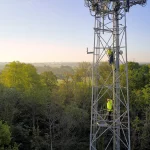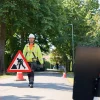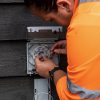EU Publishes 2022 Broadband Connectivity Progress Study vs UK

The European Commission recently published their annual 2022 Digital Economy and Society Index (DESI), which charts how the EU’s fixed line broadband ISP and mobile networks compare across all of its 27 countries. The UK was removed from this report post-Brexit, but it’s still possible to see how we compare by using Ofcom’s data.
Just to recap. The EU’s main goal for digital infrastructure is for every European household to have access to “high-speed internet” coverage by the end of 2025 (defined as 100Mbps+) and gigabit (1000Mbps+) connectivity by the end of 2030. Today’s new report, which is based on data from last year, is partly intended to help gauge the progress toward achieving those goals.
By comparison, the UK’s £5bn Project Gigabit programme aims to extend gigabit-capable broadband to reach at least 85% of UK premises by the end of 2025, before hopefully nationwide coverage (c. 99%) by around 2030 (here). The public funding for this is focused upon aiding the final 20% of hardest to reach premises, where commercial deployments may struggle.
Advertisement
According to Ofcom’s latest data to January 2022 (roughly 6 months more recent than the EU’s data), some 96% of UK premises could access a 30Mbps+ connection, while 66% are able to access gigabit broadband (via FTTP and Hybrid Fibre Coax) and that falls to 33% when only looking at FTTP. As for mobile connectivity, over 98% of premises (outdoor) have access to 4G and between 47-62% can access 5G from at least one operator.
Now let’s see how the EU compares more generally, before taking a country-specific look.

We should point out that NGA (Next Generation Access) broadband generally means fixed lines that can deliver so-called “superfast” download speeds (30Mbps+) above, while VHCN networks are really just another way of identifying both gigabit-capable FTTP and DOCSIS 3.1 / Hybrid Fibre Coax or better networks.
Advertisement
The UK clearly does a better job than the EU for NGA, and we’re not far behind for VHCN, although FTTP coverage remains somewhat of a weak point and this becomes clearer when you look at the country-specific breakdowns below. None of this is surprising because some EU states have been rolling out FTTP, at scale, for a decade longer than the UK.


Malta is leading the pack above with 100% of VHCN coverage, followed by Luxembourg, Denmark Spain, Latvia, the Netherlands and Portugal with above 90% coverage. The poorest performers were Greece (20%), Cyprus (41%), Italy (44%) and Austria (45%).
Advertisement
However, the picture below is much more varied when we examine FTTP coverage, where some countries are a lot further ahead than others due to having started their deployments much earlier. Latvia, Spain, Portugal, Romania and Bulgaria are leading with at least or above 85% FTTP coverage.
By comparison, Belgium, Germany and Greece are lagging behind the other EU countries, with below 20% FTTP coverage. The UK, had it been included, would probably place in the bottom third of this chart. However, the UK’s current pace of FTTP build is one of the fastest in the world (here), so it’s not all bad news.
Finally, rural FTTP coverage in the EU is much lower than overall coverage, standing at 34%. No surprise there as rural areas are often the last to benefit.

Comparing mobile network coverage is a little more challenging because Ofcom has a different methodology to that of the EU and the definitions can differ, thus we’ll largely leave this one up to reader interpretation. Broadly speaking, the EU and UK appear to be at a similar level for 4G coverage, but we’ve got a long way to go on 5G and so does much of the EU.
The highest 5G coverage levels were recorded in Italy, Denmark and the Netherlands, all three being above 90%!


The full report contains a lot more data, albeit covering areas that are harder to examine without directly comparable data for the UK to play with. Ofcom should be able to fill in some gaps when they publish their annual infrastructure report at the end of this year, but in the meantime you can check out the full DESI index below.
2022 Digital Economy and Society Index (DESI)
https://digital-strategy.ec.europa.eu/en/policies/desi
Mark is a professional technology writer, IT consultant and computer engineer from Dorset (England), he also founded ISPreview in 1999 and enjoys analysing the latest telecoms and broadband developments. Find me on X (Twitter), Mastodon, Facebook, BlueSky, Threads.net and Linkedin.
« BT Successfully Aggregate Four 5G Bands in Standalone Network






















































7+ years experience
If Northern Ireland was compared to the rest of the EU, how would it rank? The 2017 DUP confidence and supply funding has been absolutely transformative in NI. It’s £150m is building FTTP in all rural areas.
According to Think Broadband, using data from the same period as the European Commission study, Northern Ireland had 90% NGA access and 74.89% VHCN. The best comparison is with the Irish Republic, which seems to have bettered the north on both counts. Interestingly, some EU member states such as Ireland chose to invest more than 30% of their Recovery and Resilience Facility (RRF) allocation following the Covid pandemic towards digital development. On a per capita basis this is not very far from the £150m you mention (30% of €915m). Had the UK remained in the EU, it would have received one of the largest per capita handouts.
According to the Connected Nations Update: Spring 2021 last September, NI was sitting on almost 70% FTTP and RoI, according to this more recent report, seems to be on 48% FTTP. I read a report recently, I can’t turn up the link, that NI is closing in on 86% FTTP with 99% FTTP by 2025. That’s incredible and is bound to be near chart topping in Europe.